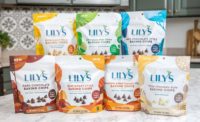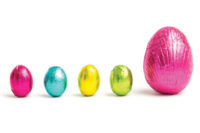How were Hershey’s seasonal candy sales? What’s going on with the company’s expansion into the snacking category? Why are they releasing a revamped sugar-free candy line?
The Hershey Co. answered all these questions and more during its fourth quarter earnings call, which was held on Feb. 4.
“We are excited about the progress we’ve made and the opportunities we have ahead of us,” said Michele Buck, chairman of the board, president and CEO, on the call. “While 2021 will continue to be uncertain, we remain focused on understanding our consumers’ needs and the world around them, continuing to be part of important traditions and new occasions and executing with excellence against the things within our control, while building strategies and capabilities for the future."
One the call, Buck said Hershey had "a strong finish to the year, with fourth quarter reported net sales growth of plus 5.7 percent, an adjusted EPS growth of plus 16.4 percent, and U.S. confectionery share gains of almost 160 basis points."
Buck and Steve Voskuil, senior V.P. and chief financial officer, both shared updates and insights during the call. Below are the most noteworthy takeaways.
On COVID-19’s impact

Buck:
COVID-19 has had a positive impact on certain confectionery products and channels while having a negative impact on others. Despite changes to what and where consumers are eating, we have seen our category and our trusted brands remain important, particularly when it comes to celebrating seasons and spending time at home with family.
On new products:

Buck:
We have a permissible line of products to really address that benefit of better-for-you, that we are underdeveloped in across our portfolio, and that will include Kit Kat Thins, which is an addition to what has been an already launch of a successful platform with Reese’s Thins.
Our Reese’s Stuffed with Pretzels and Kit Kat Mocha items are already in market, and they provide new textures and flavors for some of our best- selling brands.
On re-launching the sugar-free line:

Buck:
We are also relaunching our sugar-free line to zero sugar, really focusing on Hershey and Reese’s, and launching Hershey and Reese’s organic products. Those are the highlights for the year, and I would say, overall, if you look at our innovation, the level of innovation is about comparable to prior year.
This spring we are excited to expand our better-for-you confectionery platform with the launch of Kit Kat Thins and our Zero-Sugar and Organic lines.
Our sugar-free platform has been performing very well, and we believe this will enable us to reach more households and provide consumers with more great tasting ways to enjoy their favorite Hershey brands. And while the Organic chocolate market is small, it is growing rapidly, and we are excited to bring consumers great tasting organic versions of Reese’s and Hershey’s through this targeted launch.
A lot of the proposition is kind of relaunch, rebranding, to think about this as a product that we launched many, many years ago more as sugar-free for diabetics, which is what that was about, I don’t know, call it 20 years ago, probably, and, really, the bulk of the relaunch is about repositioning sugar-free in a way that is more contemporary.
Look at beverages and zero sugar, and lots of other categories, I mean, those products are just positioned entirely differently, in a much more contemporary way, and that’s really our goal. We actually think that the products are pretty good-tasting, too, and we’re getting good responses from consumers, but it is a lot about the repositioning of them.
On gum and mints sales:

Editor's note: Gum and mints have taken huge hits across the confectionery industry as consumers changed their daily habits in response to the pandemic. As less people left the house, they became less likely to purchase gum and mints at stores.
Buck:
Clearly, there was pressure on mints and gum relative to COVID as a segment, but part of what you might be seeing is how frequently something scans versus high frequency, which can sometimes impact what distribution actually looks like. Sometimes, it’s there and not scanning.
We haven’t had any kind of material changes in our brands and portfolio broadly. We feel pretty good about our portfolio. It’s largely focused on Ice Breakers as a key brand, which has strong points of competitive differentiation in the product and does well in the brand. So, we’re feeling pretty good about where we are in distribution, overall, for us and our brands.
On seasonal sales:

Buck:
Seasons will remain an important driver of our business in 2021.
[The year] 2020 proved how important seasonal celebrations and rituals are to consumers, how creative they are at finding new ways to enjoy them in a safe way, and how important our category and brands are to these celebrations.
We continued to leverage our strong consumer insights and deep category expertise to provide consumers with the right products and inspiration to celebrate the holidays in November and December. Our strong execution and tailored media helped drive sales increases across key occasions, from decorating, to baking, to stocking stuffers and gifts.
Hershey holiday retail sales grew 4.8 percent versus category growth of 0.7 percent, resulting in a seasonal market share gain of 117 basis points. We expect our strong portfolio of brands and advantaged supply chain execution will enable us to keep this momentum going for Valentine’s Day and Easter.
The most significant portion of our over-delivery in Q4 was seasons, it was probably about two-thirds of our over-delivery, and I would call it somewhat one-time in nature, if you think about it.
There were two parts to that.
One was we did have retailers requesting early shipment, so they could make sure that they had adequate supply as they came into 2021, so those shipments were incremental, and then we also had exceptionally strong sell-through both for Halloween and for holiday, and that has kind of a knock-on effect, where we then had less discounting required post the holiday and less cannibalization of the everyday business, so you kind of get back to the everyday business even more quickly.
Those investments and the focus that we put both in terms of media and in-store merchandising to drive category growth during the season really paid off for us, but that was kind of the single, biggest factor that was different than we had anticipated.
On Easter 2021

Buck:
Easter is our second largest season, and we began shipping in late December.
In 2021, Easter is one week earlier than last year, which has historically resulted in slightly lower category sales.
Easter is a family-centered holiday rooted in strong at-home traditions, with five of the seven core occasions occurring at home, from baking to filling baskets. These occasions performed well last year during the onset of the pandemic, and we believe they will perform well again this year as consumers are even better equipped to celebrate and shop safely.
Given our strong portfolio and execution, we expect to outperform the category for the season.
On eCommerce sales

Buck:
Our e-commerce net sales now represent approximately 5 percent of our company sales after more than doubling in 2020. We expect another quarter of strong growth in Q1 before trends stabilize in Q2 as we begin lapping last year’s significant increases.
On potential mergers and acquisitions:

Voskuil:
I think, from an appetite standpoint, we have the appetite, and the second piece is we have a great balance sheet.
We generate a lot of cash, we’ve got flexibility, we like where we’re at, and so we’re poised for the environment that we’re in....We’re aware of the external environment and where interest rates are and what may or may not be hitting the market, and we want to be able to participate in the growth, just like everybody else.
On its snack brands and expanding into the sector:

Buck:
Incremental occasion is important for us, leveraging the capabilities, and then, importantly, making sure that we do a very measured expansion.
We want to focus on confection, add an area, and then really play to win there, and make sure we don’t spread ourselves too thin, similarly to what I would say we do international, where we have a focused, select set of markets that we prioritize, that we really want to play to win, as opposed to spreading ourselves too thin.
Skinny Pop had a strong year, with retail sales growth of 10.8 percent in measured channels, maintaining its number two ready-to-eat popcorn share of 19.5 percent.
Pirate’s Booty also grew in 2020, with retail sales growth of almost 4 percent in traditional channels. Both brands have new campaigns in 2021 and will continue to focus on core brand velocities and distribution growth.
Our ONE nutrition bar business had a difficult year in 2020, as category trends were significantly impacted by COVID-19. While overall retail sales declined approximately 5 percent for the year, the brand gained approximately 20 basis points of market share.
As we progressed through 2020, some retailers began to shift space from on-the-go nutrition bars to in-home ready to drink protein and powders to align with COVID-19 trends. Based on discussions with retailers, we believe these trends are temporary, and we expect bars to recover as consumer mobility increases. The team is continuing to focus on supporting top SKUs and smart innovation in mini-bars and plant-based bars, so that we are well positioned to grow as trends reverse.
I think retailers, they’re always looking to try and optimize their space according to what the current consumer demand is, and so — hey, nobody knows how long — what the curve of the pandemic is going to look like, so I can’t tell you a specific time when it will shift, and, obviously, it will shift at different times with different retailers, too, based on who their consumers are. I would say we have a definitive timeline and we are focused on, one, how we make sure that we’ve got the right support behind a brand and the right innovation, relative to minis, which we think is a big idea, and also plant-based, which are on-trend, so that as the category does come back, we are well positioned to capture that.
On Cocoa Sustainability and the LID

Editor's note: Ghana and Ivory Coast have added a Living Income Differential to cocoa from the two countries, which increase the price. It requires all companies buying cocoa from either of the two countries to pay $400 more per ton above the market selling price, and the additional money will help subsidize cocoa farmer incomes.
Voskuil:
Let me take a minute to discuss cocoa in a bit more detail given some of the more significant changes the market is experiencing this year.
First, as we have shared before, we are fully participating in the Living Income Differential for our ongoing and substantial purchases from the 2020 and 2021 Cote d’Ivoire and Ghana crops.
This is one of many factors impacting our overall costs.
Another key component is supply and demand, not only of overall cocoa beans but also of key cocoa derivatives, including liquor, butter and powder.
Hershey, like many manufacturers, relies primarily on cocoa liquor and butter to manufacture chocolate.
As many of you know, COVID-19 has pressured global demand for chocolate while supply has stayed the same in many markets and increased in others. This has created temporary market opportunities throughout the year and led to declining cocoa butter prices, which softened the impact of the increased investment associated with the Living Income Differential this year.





